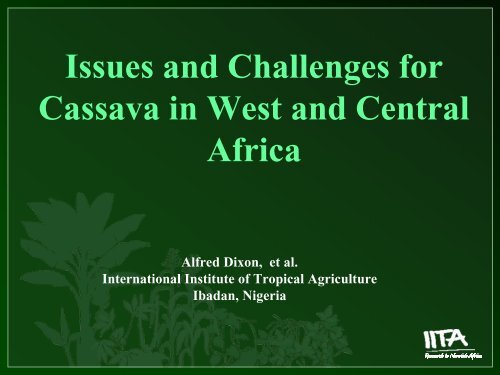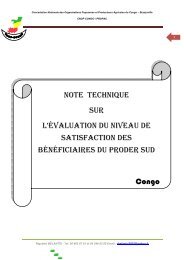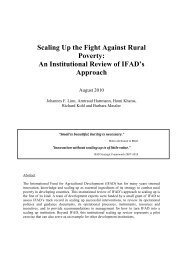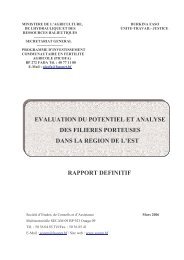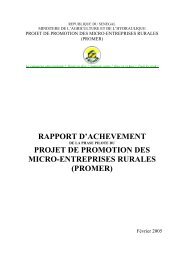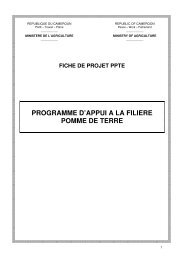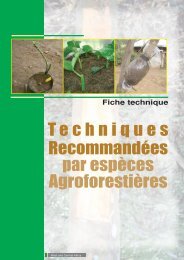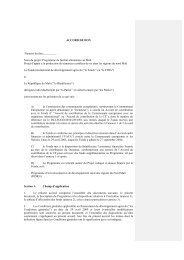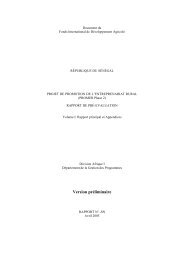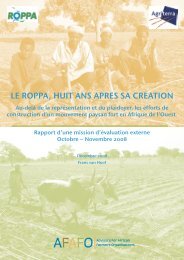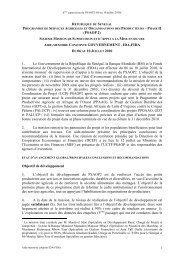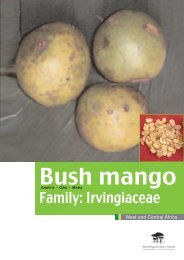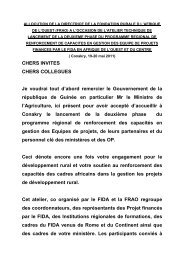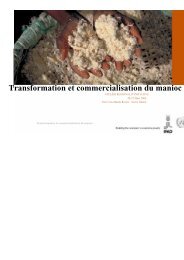Issues and Challenges for Cassava in West and Central ... - FIDAfrique
Issues and Challenges for Cassava in West and Central ... - FIDAfrique
Issues and Challenges for Cassava in West and Central ... - FIDAfrique
You also want an ePaper? Increase the reach of your titles
YUMPU automatically turns print PDFs into web optimized ePapers that Google loves.
<strong>Issues</strong> <strong>and</strong> <strong>Challenges</strong> <strong>for</strong><br />
<strong>Cassava</strong> <strong>in</strong> <strong>West</strong> <strong>and</strong> <strong>Central</strong><br />
Africa<br />
Alfred Dixon, et al.<br />
International Institute of Tropical Agriculture<br />
Ibadan, Nigeria
<strong>Cassava</strong> is an appropriate commodity to feature <strong>in</strong> SSA future<br />
economic development: national, regional <strong>and</strong> <strong>in</strong>ternational<br />
markets <strong>and</strong> trade (GCDS, NEPAD, ECOWAS. etc.)<br />
Five ma<strong>in</strong> roles: fam<strong>in</strong>e reserve crop; rural food staple; cash crop <strong>for</strong><br />
urban consumption; <strong>in</strong>dustrial raw material; <strong>and</strong> <strong>for</strong>eign exchange<br />
earner<br />
But<br />
Too much emphasis on production (cyclic glut <strong>and</strong> dis<strong>in</strong>centive)<br />
<strong>Cassava</strong> production per se: NOT THE<br />
CHALLENGE
Production<br />
Higher volume Lower<br />
Price<br />
Production<br />
Low volume High Price<br />
Kg per person<br />
AVOIDING the SEESAW<br />
The glut challenge<br />
Production (Supply)<br />
Food (Dem<strong>and</strong>)<br />
1974 1978 1982 1986 1990 1994 1998 2002 2004<br />
Price
The challenge today is to:<br />
<strong>in</strong>crease productivity, market<strong>in</strong>g opportunities <strong>and</strong><br />
profitability<br />
Shift from<br />
Production-oriented Research <strong>for</strong> Development<br />
(Supply as the driver)<br />
to<br />
Market-oriented Research <strong>for</strong> Development<br />
(Market as the driver)
<strong>Issues</strong> : Efficiency/competitiveness <strong>and</strong> modernization<br />
Why?<br />
Restricted market opportunities <strong>for</strong> the f<strong>in</strong>al products<br />
<strong>and</strong> exp<strong>and</strong>ed production<br />
Impeded by high cost of production, <strong>and</strong><br />
product qualities both of which are results of<br />
dependence on traditional production <strong>and</strong><br />
process<strong>in</strong>g technologies
Production is smaller-holder, subsistence, <strong>and</strong><br />
fragmented<br />
System is complex<br />
Lacks economy of scale<br />
Rudimentary equipment<br />
No agrochemicals/<strong>in</strong>puts<br />
unreliable supply<br />
uneven product quality<br />
low producer prices<br />
costly market<strong>in</strong>g structure<br />
• Low-scale farm<strong>in</strong>g: not choice but careful <strong>and</strong> realistic<br />
adjustment to resources available to farmers<br />
low use of <strong>in</strong>puts<br />
rudimentary<br />
technologies<br />
large post-harvest<br />
losses<br />
m<strong>in</strong>imal process<strong>in</strong>g
Costs per unit weight of output:<br />
Constant as yield <strong>in</strong>creased, because the process<strong>in</strong>g technique<br />
employed was manual with a low level of capital <strong>in</strong>vestment<br />
• About 10% of the processors could produce cassava pellets below the<br />
world market price<br />
35<br />
• Process<strong>in</strong>g cost of pellets <strong>in</strong> 1996 (Note: N80 =<br />
30<br />
approx. US$ 1)<br />
Naira per ton (1000)<br />
25<br />
20<br />
15<br />
Mean Cost= N22,000<br />
World Market Price (FOB) = N 13,000<br />
10<br />
0 9 18 27 36 45 54 63 72 81 90 99<br />
Frequency (%) of process<strong>in</strong>g units<br />
Source: Nweke, F. I. <strong>and</strong> J. K. Lynam. 1997. <strong>Cassava</strong> <strong>in</strong> Africa. African Journal of Root <strong>and</strong> Tuber Crops,<br />
2: 10-13.
Field production costs (cost of plant<strong>in</strong>g materials <strong>and</strong> field<br />
operations’ labor per unit weight of output) :<br />
decl<strong>in</strong>es as yield <strong>in</strong>creases because most of such costs<br />
are constant per unit area, irrespective of the yield
Constra<strong>in</strong>ts be<strong>in</strong>g faced today by cassava production <strong>in</strong> WCA<br />
Non-commercial production systems <strong>in</strong> small <strong>and</strong> fragmented<br />
farm hold<strong>in</strong>gs (0.2 – 2 ha., Ave: 0.5 ha): crop of last resort<br />
High production <strong>and</strong> process<strong>in</strong>g costs <strong>and</strong> poor product qualities<br />
Emerg<strong>in</strong>g pest threat (cassava mosaic disease variants, <strong>Cassava</strong><br />
brown streak disease, African root <strong>and</strong> tuber scale)<br />
Absence of strong producers <strong>and</strong> processors’ organizations
Untapped market opportunities, absence of susta<strong>in</strong>able<br />
market <strong>in</strong><strong>for</strong>mation systems, <strong>and</strong> availability of reliable data<br />
Inadequate access to credit <strong>and</strong> other <strong>in</strong>puts to<br />
producers/processors<br />
Inadequate number of relevant agro-process<strong>in</strong>g <strong>in</strong>dustries<br />
Energy<br />
Constra<strong>in</strong>ts cont’d<br />
Globalization <strong>and</strong> trade liberalization (WTO)
Address<strong>in</strong>g the constra<strong>in</strong>ts<br />
The New Approach <strong>for</strong> a New Century:<br />
We must produce food <strong>in</strong> ways that create wealth<br />
Food security is not just meal on the table or <strong>in</strong> the mouth<br />
but also money <strong>in</strong> the pocket<br />
Increase the productivity of the entire cassava food system to<br />
drive down the price of cassava to rural <strong>and</strong> urban<br />
consumers <strong>and</strong> other end-users<br />
Emphasiz<strong>in</strong>g only production technologies, will be<br />
sell<strong>in</strong>g cassava short
Address all constra<strong>in</strong>ts from production to consumption through<br />
synchronised <strong>and</strong> <strong>in</strong>tegrated approach <strong>in</strong> the commodity cha<strong>in</strong><br />
Activity Framework<br />
Outcome<br />
Technology development/assessment<br />
Technology transfer<br />
Enterprise development<br />
Market development <strong>and</strong> trade<br />
Human <strong>and</strong> <strong>in</strong>stitutional capacity<br />
build<strong>in</strong>g<br />
Impact assessment<br />
Commodity cha<strong>in</strong> approach<br />
Productivity <strong>in</strong>creased<br />
Agro-<strong>in</strong>put enterprises developed<br />
Improved quality<br />
Reduced post harvest losses<br />
Value add<strong>in</strong>g<br />
Markets<br />
Markets<br />
diversified<br />
diversified<br />
Rural <strong>in</strong>comes <strong>in</strong>creased<br />
Diets diversified
Pathway<br />
Develop<strong>in</strong>g commercial “w<strong>in</strong>dows” <strong>for</strong> producers through<br />
organization, technology <strong>and</strong> improved products <strong>and</strong><br />
enhanc<strong>in</strong>g market<strong>in</strong>g l<strong>in</strong>kages of cassava produce with high<br />
levels of added-value<br />
Subsistence<br />
Meet subsistence needs<br />
Commercialization needs science:<br />
Complex Problems: Development + science = better<br />
Commercial use
Ongo<strong>in</strong>g or proposed research activities<br />
1. Intensification <strong>and</strong> commercialization of cassava <strong>in</strong>clud<strong>in</strong>g l<strong>and</strong><br />
development<br />
2. Mechanization with appropriate equipment (production <strong>and</strong><br />
postharvest)<br />
3. Participatory methods <strong>and</strong> processes<br />
4. Postharvest process<strong>in</strong>g, quality <strong>and</strong> st<strong>and</strong>ards<br />
5. Supply cha<strong>in</strong> structure <strong>and</strong> management<br />
6. Susta<strong>in</strong>able MIS <strong>and</strong> l<strong>in</strong>kages to market<br />
7. Private sector <strong>in</strong>vestment <strong>and</strong> <strong>in</strong>volvement<br />
8. Public-private partnerships<br />
9. Solicit<strong>in</strong>g <strong>for</strong> adequate fund<strong>in</strong>g <strong>for</strong> R&D<br />
10. Policy dialogue <strong>for</strong> the necessary <strong>in</strong>frastructure <strong>and</strong> enabl<strong>in</strong>g<br />
environment
More efficient field production (<strong>in</strong>crease productivity)<br />
Better services to field production (response to <strong>in</strong>puts)<br />
Development <strong>and</strong> delivery of technologies geared to more<br />
efficient production, postharvest <strong>and</strong> market<strong>in</strong>g operations<br />
More attention to postharvest (quality <strong>and</strong> quantity) <strong>for</strong><br />
def<strong>in</strong>ed markets)<br />
Network<strong>in</strong>g, partnership <strong>and</strong> cooperation to strengthen<br />
national organizations<br />
Policy <strong>and</strong> advocacy<br />
Focus!
Germplasm development<br />
Multiple pest resistance<br />
Early maturity<br />
High fresh, dry <strong>and</strong> starch yield<br />
High beta carotene<br />
Low HCN <strong>and</strong> root meal<strong>in</strong>ess<br />
Suitability <strong>for</strong> Intercropp<strong>in</strong>g<br />
Weed suppression<br />
Ease of peel<strong>in</strong>g<br />
Varieties <strong>for</strong> Specific products<br />
• Maggi cube<br />
• Ethanol<br />
• Quality gari<br />
• Quality flour<br />
• Quality starch<br />
• Quality fufu<br />
• Quality leaves<br />
• Animal feeds
Empirical data from basel<strong>in</strong>e study: labour costs <strong>in</strong>creased 4<br />
times <strong>in</strong> real terms <strong>in</strong> last 15 years<br />
We must mechanize!!!<br />
Don’t use heavy mach<strong>in</strong>ery <strong>in</strong> fragile soils<br />
<br />
Promote use of light mach<strong>in</strong>ery such the<br />
rugged power tiller <strong>and</strong> accessories<br />
1 ha/hour /3 persons<br />
Manual plant<strong>in</strong>g:<br />
1ha/day (12 persons)<br />
US$/ton<br />
Cost Reduction Effects<br />
35<br />
30<br />
25<br />
20<br />
15<br />
10<br />
5<br />
0<br />
100% 13.6% 11.6% 27.9% 40.5%<br />
29.4<br />
Traditional<br />
system<br />
25.4<br />
Improved<br />
varieties<br />
26<br />
Mechanized<br />
plant<strong>in</strong>g<br />
21.2<br />
Mechanized<br />
plant<strong>in</strong>g <strong>and</strong><br />
harvest<strong>in</strong>g<br />
17.5<br />
Mechanized<br />
plant<strong>in</strong>g<br />
&harvest<strong>in</strong>g<br />
&improved<br />
varieties
Postharvest consideration<br />
Top 5 varieties released <strong>in</strong> 2005 by the<br />
Nigerian National committee on the<br />
registration <strong>and</strong> release of crop varieties<br />
<strong>and</strong> livestock breeds: 98/0505, TME 419,<br />
97/2205, 98/0581, 98/0510<br />
• Yield > 25 t/ha, DM >30%, CMDresistant<br />
Industrial Food Livestock<br />
1 M98/0028 95/0289 97/2205<br />
2 TME419 92/0057 M98/0040<br />
3 97/4763 96/1632 99/6012<br />
4 98/0505 TME419 98/0510<br />
5 M98/0040 98/0505 96/1565<br />
6 99/6012 97/2205 92/0325<br />
7 96/0523 98/0581 M98/0028<br />
8 92/0325 92/0326 TME 419<br />
9 97/2205 92B/00061 97/4763<br />
10 M98/0068 98/0510 98/0581
Develop<strong>in</strong>g cassava-based Livestock Feeds & Feedstuff Industry<br />
“<strong>Cassava</strong> leaf”<br />
The tropical Alfafa &<br />
renewable green gold<br />
Nigeria is loos<strong>in</strong>g $7bn/P.A from nonexploitation<br />
of this resource<br />
Feed <strong>for</strong> Poultry<br />
Animal feed pellets<br />
Feed <strong>for</strong><br />
Pig
Domestic Market<strong>in</strong>g Network <strong>and</strong> Cross Border Trade<br />
Number of rural markets<br />
Lagos<br />
Kebbi<br />
Sokoto<br />
Zamfara<br />
Bayelsa<br />
Anambra<br />
Rivers<br />
Abuja<br />
Imo<br />
Kats<strong>in</strong>a<br />
Enugu Abia<br />
Akwa Ibom<br />
Ebonyi<br />
Kano<br />
B<strong>and</strong>a<br />
Uzairue (Kogi)<br />
Gombe<br />
(Edo)<br />
Kaduna<br />
Bauchi<br />
Urhonigbe<br />
Agor (Edo)<br />
Niger<br />
(Edo)<br />
Adamawa<br />
Ujiogba<br />
Plateau<br />
Ankpa<br />
Kwara<br />
(Edo)<br />
20 (Kogi)<br />
Nassarawa<br />
Ugbogha Oyo<br />
%<br />
Ayangba<br />
Taraba<br />
(Edo)<br />
Ekiti<br />
Kogi<br />
20 (Kogi)<br />
Figure Osun<br />
Ugbogui<br />
1. Rural markets supply<strong>in</strong>g various cassava products<br />
Benue % <strong>Cassava</strong> grow<strong>in</strong>g Aviele regions<br />
Ogun<br />
Ondo<br />
(Edo)<br />
Marg<strong>in</strong>al (Edo)<br />
Oworo 450<br />
Edo<br />
Major Awo<br />
(Kogi)<br />
Moderate (Kogi)<br />
Okpella400<br />
Ebelle<br />
Delta<br />
(Edo)<br />
350<br />
Abuja<br />
(Edo)<br />
<strong>Cassava</strong> Grow<strong>in</strong>g Population Area Ra<strong>in</strong>fall<br />
Okparake<br />
regions (Million) Ehor (Sqkm) (Edo) (mm)<br />
(FCT)<br />
(Kogi) 300<br />
Marg<strong>in</strong>al 26.29 100, 041 500 - 1000<br />
Magajiya<br />
Moderate 27.73 Ejule 54, 568 1500 - 2800<br />
300 250150<br />
0 300 Km<br />
(Kogi)<br />
Major 34.27 (Kogi)<br />
754,852 1000 - 1500<br />
200<br />
Ekpoma<br />
150<br />
(Edo)<br />
Koton Karfe<br />
Gir<strong>in</strong>ya<br />
(Kogi)<br />
100<br />
(Kogi)<br />
Keffi<br />
Ibilo (Edo)<br />
(Nasarawa) 50<br />
Karala<br />
Igueben<br />
0 (Kogi) (Edo)<br />
FRTU Kabacha FUFU CHKS FERF GARI ABCH FUFP Iruekpen STCH<br />
(Kaduna) <strong>Cassava</strong> Products (Edo)<br />
Itobe (Kogi)<br />
20<br />
%<br />
20<br />
%<br />
15<br />
10<br />
%<br />
%<br />
20<br />
10<br />
%<br />
%<br />
20<br />
25<br />
%<br />
%<br />
20 20<br />
50<br />
% %<br />
%<br />
40<br />
%<br />
20<br />
%<br />
30<br />
Yeruwata<br />
(Benue)<br />
40<br />
10<br />
%<br />
20<br />
20<br />
%<br />
%<br />
10<br />
%<br />
%<br />
20<br />
%<br />
10<br />
%<br />
30<br />
%<br />
20<br />
20<br />
%<br />
% 30<br />
%<br />
20<br />
Irrua (Edo)<br />
% 30<br />
%<br />
100%<br />
20<br />
% %<br />
Agbede<br />
(Edo)<br />
Cross River<br />
Jigawa<br />
Yobe<br />
Lake Chad<br />
Borno<br />
K<br />
1. Eight pr<strong>in</strong>cipal cassava products<br />
are traded <strong>in</strong> the Nigerian local<br />
markets<br />
2. Gari <strong>and</strong> chips (flour) are the<br />
most important cross border<br />
traded commodities <strong>and</strong> the<br />
volumes traded are large contrary<br />
to expectations<br />
3. Product prices differ by region<br />
be<strong>in</strong>g most expensive <strong>in</strong> the north<br />
& south <strong>and</strong> least expensive <strong>in</strong> the<br />
central regions<br />
4. Traditional market responds<br />
easily to local dem<strong>and</strong> through the<br />
price mechanism <strong>and</strong> established<br />
networks
Market In<strong>for</strong>mation System (MIS): miss<strong>in</strong>g l<strong>in</strong>k <strong>in</strong> market<br />
development<br />
- -<br />
- -<br />
No readily available disaggregated data that would allow comparisons of volumes,<br />
prices, seasonality of supply <strong>and</strong> evaluations of opportunities <strong>in</strong> the domestic <strong>and</strong><br />
export markets<br />
Weak databases that are either too old or too limited <strong>in</strong> content<br />
Localised In<strong>for</strong>mation Service<br />
- -<br />
- -<br />
Producers<br />
- -<br />
- -<br />
Traders<br />
Institutions/<br />
Mechanisms<br />
Industrial Dem<strong>and</strong><br />
Agro-processor<br />
No quick reference decision mak<strong>in</strong>g tools to guide <strong>in</strong>vestments <strong>in</strong> agribus<strong>in</strong>ess
www.cassavabiz.org
Improve on market analysis <strong>and</strong> <strong>for</strong>ecast<strong>in</strong>g<br />
Susta<strong>in</strong>ability<br />
<strong>Challenges</strong> <strong>for</strong> MIS<br />
Private Sector participation & fund<strong>in</strong>g (How will the<br />
PS benefit?)
Capacity Build<strong>in</strong>g<br />
Agro-<strong>in</strong>put Dealers<br />
Organization <strong>and</strong> L<strong>in</strong>kages<br />
Market <strong>in</strong><strong>for</strong>mation service (MIS)<br />
- -<br />
- -<br />
- -<br />
- -<br />
- -<br />
- -<br />
F<strong>in</strong>ancial <strong>in</strong>stitutions<br />
- -<br />
- -<br />
Clusters of farms,<br />
MPCs/SMEs<br />
Agro-allied <strong>in</strong>dustry
L<strong>in</strong>kages already <strong>in</strong> place<br />
• Over 50 collaborat<strong>in</strong>g Institutions, <strong>in</strong> Nigeria alone
Supply<br />
Side<br />
Farmers<br />
Producer<br />
Organizations<br />
(CGAN)<br />
Partnerships required to help address constra<strong>in</strong>ts<br />
Farmer<br />
Bus<strong>in</strong>ess<br />
Associations<br />
&<br />
Other Bus<strong>in</strong>ess Dev.<br />
Service Providers<br />
Global context <strong>for</strong> competition: national agribus<strong>in</strong>ess strategy<br />
<strong>Cassava</strong> Industry<br />
Chips<br />
Flour<br />
Starch<br />
Ethanol<br />
Dem<strong>and</strong><br />
Side<br />
Exporters (APSE)<br />
Processors<br />
(e.g CAPAN, PAN, MBAN,<br />
FMAN)<br />
Traders &<br />
Merchants (PS?)<br />
Input Suppliers<br />
(e.g. CEFAN, PSO)<br />
Transporters<br />
Related <strong>and</strong> Support<strong>in</strong>g Institutions (NURTW)<br />
Government (e.g. FMARD, FMC, FMI, RTEP, etc)<br />
Regulatory Agencies (e.g. NAFDAC, SON, Customs)<br />
Research <strong>and</strong> Academic Institutions (e.g. IITA, other CG centers, ARI’s, NRCRI, NCAM,<br />
Universities<br />
Trade & Sub sector Associations (e.g. NASSI, NASME, Chambers of<br />
Commerce, etc)<br />
F<strong>in</strong>ancial Institutions <strong>and</strong> NGOs (e.g. MFIs)<br />
Donors
Key issue regard<strong>in</strong>g the process<strong>in</strong>g <strong>and</strong> market<strong>in</strong>g of cassava<br />
Development <strong>and</strong> utilization of appropriate (production <strong>and</strong><br />
process<strong>in</strong>g) mach<strong>in</strong>ery to suit different economies of scale, yet<br />
profitable, especially <strong>for</strong> dry<strong>in</strong>g <strong>and</strong> peel<strong>in</strong>g to actualize the<br />
|”<strong>Cassava</strong> Trans<strong>for</strong>mation” <strong>in</strong> WCA – Rank 1<br />
Waste/residue management – Rank 2
Th<strong>in</strong>k Big<br />
Start Small<br />
Scale-out Fast<br />
<strong>in</strong>come<br />
wellbe<strong>in</strong>g<br />
health<br />
future


